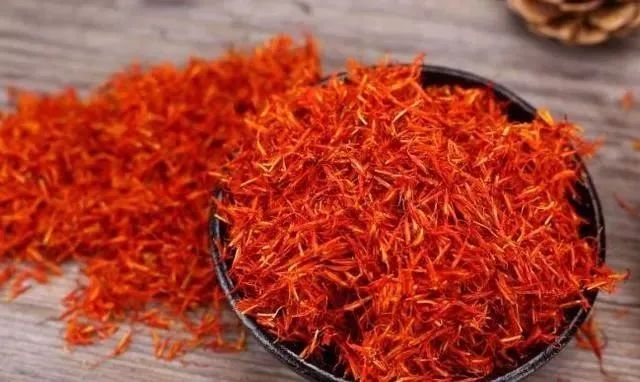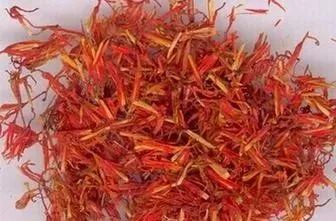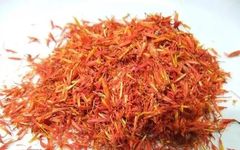The Complete Collection of Old Remedies for Your Health Knowledge
Click below to follow for free ↓↓↓
Safflower (Honghua)
【Alias】 Grass Safflower, Red Blue Flower, Du Honghua, Huai Honghua, etc.
【Properties and Channels】 Pungent in flavor, warm in nature, enters the Heart and Liver meridians.
【Modern Research】 Safflower mainly contains safflower yellow, new safflower glycosides, safflower glycosides, safflower yellow pigment, and safflower oil. Pharmacological studies indicate that safflower has a stimulating effect on the smooth muscles of the uterus and intestines, and also exhibits effects such as inhibiting platelet aggregation, reducing whole blood viscosity, analgesic properties, protecting and improving myocardial ischemia, reducing the area of myocardial infarction, countering arrhythmias, lowering blood pressure, enhancing hypoxia tolerance, sedative effects, anticonvulsant properties, anti-inflammatory effects, and immunosuppression.
【Selection and Storage】 When selecting safflower, choose those with long flower crowns, bright red-yellow color, vivid appearance, and soft texture without thorns. Store in a dry, sealed container in a cool, dry place to prevent moisture and pests.

【Effects and Characteristics】
According to the “Book of Nature” compiled by Zhang Hua during the Jin Dynasty, Zhang Qian brought back many plants from the Western Regions, including walnuts, grapes, pomegranates, broad beans, alfalfa, and among them was the excellent medicine for invigorating blood circulation—safflower. Safflower has the effects of invigorating blood circulation, regulating menstruation, and alleviating pain, commonly used to treat blood stasis, amenorrhea, dysmenorrhea, and postpartum abdominal pain due to stasis. It is a commonly used herb for treating blood stasis conditions, especially in gynecology. The “Jin Kui Yao Lue” mentions using it alone to treat dysmenorrhea, and it can also be combined with qi-regulating, blood-invigorating, and blood-nourishing herbs, such as combining with Yan Hu Suo, Xiang Fu, Dang Gui, Chi Shao, and Tao Ren to regulate qi, invigorate blood, and alleviate pain, treating amenorrhea and dysmenorrhea. This herb can enhance the effects of blood-invigorating and menstruation-regulating when used with blood-breaking and stasis-eliminating herbs, and is used to treat masses and accumulations. Safflower can also be used for beauty, as its blood-invigorating properties can help eliminate spots caused by blood stasis, often combined with cooling blood-clearing herbs like Zi Cao and Da Qing Ye.
Modern women face dual pressures from work and family, making qi stagnation and blood stasis significant factors affecting women’s health. Irregular menstruation and skin spots indicate that there may be blood stasis in the body that needs to be cleared. Traditional Chinese Medicine (TCM) believes that skin spots are related to various factors, including internal blood stasis. At this time, simply using external whitening cosmetics often cannot achieve lasting and satisfactory results; internal overall conditioning is needed to achieve beauty from within. Additionally, safflower seed oil contains a high level of linoleic acid, which helps lower blood lipids and serum cholesterol, soften and dilate arteries, prevent atherosclerosis, increase blood circulation, and protect the heart.
The common method of use for safflower is to decoct it in water, with a dosage of 3-10 grams. It is important to note that safflower is contraindicated for pregnant women, and those with menstrual periods, bleeding tendencies, or a history of ulcers should use it with caution.
Nowadays, people often hear about “Crocus sativus” and “Western safflower,” which actually refer to the same safflower, the stigma of the plant Crocus sativus. It is important to note that in some places, grass safflower is also referred to as Western safflower, which should be distinguished from saffron. Saffron is sweet in flavor, slightly cold in nature, enters the Heart and Liver meridians, and has similar effects to safflower. The clinical applications and contraindications are also generally the same, but saffron is stronger and more expensive due to its lower yield, so the clinical dosage should be small, generally 1.5-3 grams.

【Proven Recipes】
Safflower Dan Shen Yu Jin Tablets: 15 grams of safflower, 18 grams each of Dan Shen and Yu Jin, 30 grams of Gua Lou, made into a paste and pressed into 30 tablets. Take 10 tablets each time, three times a day, for a course of 4 weeks, treating coronary heart disease and angina.
Safflower Wine: 14 grams of safflower, 200 milliliters of white liquor, decocted until reduced to 100 milliliters, take 50 milliliters at a time. Invigorates blood and alleviates pain, treating abdominal stabbing pain caused by wind after childbirth or menstruation, and irregular menstruation.
Safflower Dang Gui Powder: 150 grams of Liu Qi Nu, 60 grams each of Dang Gui, Niu Xi, Zhi Gan Cao, Zi Wei Ye, Safflower, and Su Mu, 270 grams of Chi You, 45 grams each of Rou Gui and Bai Zhi, grind the above herbs into a fine powder, take 9 grams each time, mixed with hot wine. If blood does not flow for a long time, decoct safflower wine to take, treating delayed menstruation in women, or intermittent menstruation with abdominal pain and tightness in the lower abdomen.
Safflower Tao Ren Decoction: Equal parts of safflower, Dang Gui, Tao Ren, Xiang Fu, Yan Hu Suo, Chi Shao, Chuan Xiong, Ru Xiang, Dan Shen, Qing Pi, and Sheng Di Huang, decoct in water, treating menstrual obstruction due to blood stasis, with occasional abdominal pain or tightness in the lower abdomen.

【Available Medicinal Products】
Compound Yi Mu Cao Paste (Oral Liquid): Regulates menstruation, invigorates blood, disperses stasis and alleviates pain, used for menstrual irregularities, amenorrhea, lower back pain, postpartum blood dizziness, retained placenta, and pain due to blood stasis.
Gynecological Menstruation Regulating Pills: Breaks stasis, regulates menstruation, softens hardness and disperses masses, used for amenorrhea and dysmenorrhea caused by qi and blood stasis, symptoms include prolonged menstruation, abdominal pain, tenderness, chest tightness, and sighing.
Gynecological Recovery Pills: Nourishes qi and blood, invigorates blood, disperses masses, alleviates pain, used for menstrual irregularities and dysmenorrhea caused by qi and blood deficiency and blood stasis, symptoms include irregular menstruation, variable menstrual flow, blood clots, abdominal pain during menstruation, and masses.
【Classic Medicinal Dishes】
Black Bean Safflower Soup: 50 grams of black beans, 5 grams of safflower, appropriate amount of brown sugar, put black beans and safflower in a pot, add water, simmer until black beans are fully cooked, add brown sugar to complete, eat beans and drink soup, twice daily. Nourishes the liver and body, invigorates blood and regulates menstruation, used for amenorrhea.
Safflower Glutinous Rice Porridge: 10 grams each of safflower and Dang Gui, 15 grams of Dan Shen, 100 grams of glutinous rice, decoct the above herbs with appropriate amount of water, strain to obtain the juice; add glutinous rice to cook porridge, eat on an empty stomach, twice daily, nourishes blood, invigorates blood, regulates menstruation, used for menstrual irregularities and amenorrhea due to blood deficiency and stasis.
Tao Ren Safflower Sheng Di Huang Porridge: 10 grams each of Tao Ren and safflower, 20 grams of cooked Sheng Di Huang, 100 grams of rice, appropriate amount of white sugar, wrap Tao Ren, safflower, and Sheng Di Huang in clean gauze, put in a pot with rice, add appropriate amount of water and cook, after the porridge is cooked, remove the herb bag, add white sugar to taste. Invigorates blood and disperses stasis, used for acute blood stasis pelvic inflammatory disease, presenting as significant lower abdominal pain, a feeling of heaviness, a sense of bowel movement, dysmenorrhea, and yellow or reddish discharge.
The Home Remedies Hub provides you with health knowledge
Click below to follow for free ↓↓↓
Editor shares good articles with friends
1. Can San Qi Powder be eaten regularly? These 10 side effects must be noted, decide after reading!
2. Side effects of San Qi Powder: Eating San Qi this way can be deadly!
3. So precious! Over 800 home remedies, there is no illness that cannot be treated, save for future use!
4. The most comprehensive collection of massage techniques videos—those who want to learn massage should save it quickly!
Like is a form of encouragement Share to spread joy

